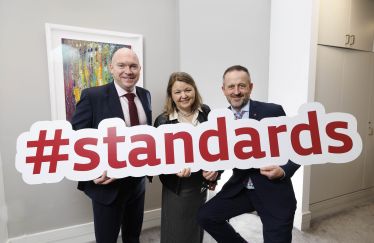Carbon Monoxide Awareness Week 2012 runs from September 24th to 30th.
As the first Carbon Monoxide Awareness Week gets underway, NSAI (National Standards Authority of Ireland) is urging the public to be aware of the dangers of Carbon Monoxide (CO) in Irish homes and businesses.
Maurice Buckley, CEO, NSAI, said: “Carbon Monoxide is an extremely toxic gas that you can’t see or smell. It is colourless, odourless and poisonous and there is no warning that it is present in your home or workplace. As part of Carbon Monoxide Awareness Week we are asking people to follow some simple safety tips to reduce the risk of poison from this deadly gas. These include carrying out regular servicing and maintenance on appliances, never blocking air vents or flues and chimneys, always ensuring that appliances are installed by qualified technician, and installing good quality Carbon Monoxide alarms.
“Look out for signs of Carbon Monoxide, such as staining or discolouration around heating appliances or vents, condensation on walls and windows, a yellow or orange flame from a gas appliance when normally blue, blockages in chimneys and flues, or any damage around appliances or flues,” he continued.
Carbon Monoxide is released as a by-product from any household appliance that burns gas, coal, oil, wood, turf, petrol or diesel when oxygen supply has been reduced. These include boilers, open fires, solid fuel stoves, portable gas heaters and gas fires. Symptoms of Carbon Monoxide poisoning are a headache which progresses to nausea, dizziness and drowsiness. It may feel like a flu bug when indoors, but people generally feel fine again when they go outside.
NSAI has the following safety tips that can be taken to reduce the risks of Carbon Monoxide poisoning in the home or workplace:
- Have your oil and gas boiler serviced every year. Ensure that gas boilers are serviced by Registered Gas Installers (RGI) and ask them to check all air vents, chimneys and flues to make sure there are no obstructions.
- Blocked vents, flues and chimneys are a major cause of Carbon Monoxide poisoning. Check outside for obstructions such as overgrown ivy and birds’ nests.
- Keep air vents clear. Do not cover vents to prevent draughts, even in cold weather.
- Get your chimney swept at least once a year.
- Install Carbon Monoxide alarms in your home or business. Don’t rely on just one alarm. Follow manufacturers’ instructions and position alarms in, or next to bedrooms, and in each room with a fossil fuel burning appliance. Carbon Monoxide alarms are a warning device and do not eliminate Carbon Monoxide. Always replace the alarm once it has reached its expiry date.
- Look for the quality marks on your Carbon Monoxide alarm. Invest in good quality alarms (from €30-€50) that comply with the appropriate European Standard, EN 50291. Look for the 'CE mark', or for 3rd party certification marks such as the 'BSI Kitemark'. Try to ensure that your Carbon Monoxide alarms are fitted with a fault signal with an end-of-life indicator.
NSAI is currently revising Irish Standard I.S. 813, Domestic Gas Installations and public comment has been invited. The draft revision of I.S. 813 is available for review and comment on NSAI @ Your Standards, Your Say.
“Standards are constantly being updated and amended to ensure that the latest advancements in safety and technology are incorporated into consumer products. NSAI continues to work with European and Irish industry to ensure that the qualities of products available on the Irish market are up to standard,” said Mr Buckley.



